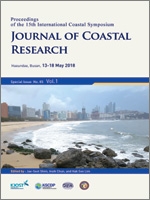López-Gutiérrez, J.S.; Esteban, M.D., and Negro, V., 2018. Wave Energy Potential Assessment and Feasibility Analysis of Wave Energy Converters. Case Study: Spanish Coast. In: Shim, J.-S.; Chun, I., and Lim, H.S. (eds.), Proceedings from the International Coastal Symposium (ICS) 2018 (Busan, Republic of Korea). Journal of Coastal Research, Special Issue No. 85, pp.1291–1295. Coconut Creek (Florida), ISSN 0749-0208.
Wave energy is one of the marine renewable energy types, essential to achieve a sustainable development. Coastal countries need to know the wave energy potential along their coasts, so its contribution to the future electricity market is estimated. Spain has noticeable variations in its average wave climate, so it is essential to analyse numerous locations. For research purposes, wave energy potential is estimated based on data from the 15 Spanish State Port buoys currently in operation in deep waters. Because these buoys were set up at different times, with some moored around 2005, the sample between 2005 and 2015 is studied with the purpose of comparing results. REDEXT buoys, arranged from highest to lowest wave energy potential, are: Villano-Sisargas (56.84 kW/m), Cabo Silleiro (53.50 kW/m), Estaca de Bares (53.36 kW/m), Cabo de Peñas (39.66 kW/m), Bilbao-Vizcaya (39.09 kW/m), Gran Canaria (23.71 kW/m), Mahón (16.21 kW/m), Cabo de Begur (13.95 kW/m), Golfo de Cádiz (12.70 kW/m), Dragonera (10.16 kW/m), Cabo de Gata (8.43 kW/m), Cabo de Palos (8.17 kW/m), Tenerife Sur (6.93 kW/m), Tarragona (6.14 kW/m) and Valencia (5.42 kW/m). Some buoys were moored in the 1990s allowing an analysis to be made of how the average wave climate has changed over the last years. Furthermore, a study is undertaken analysing the feasibility of different wave energy converters, specifically Pelamis 750 kW, Oyster 300 kW, Aquabuoy 250 kW, and SSG 20,000 kW, in the 15 buoy locations. Energy production and the capacity factor of all devices for the 15 locations are calculated, obtaining as a result that the most suitable device for all the locations studied is Oyster, and the least suitable is SSG. All the results are shown in different comparative tables and figures, with a summary of the most emphasizing information in each buoy.





